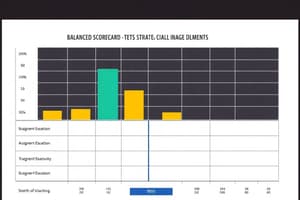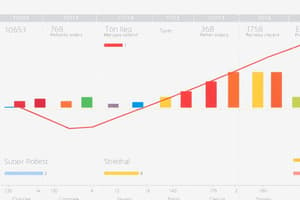Podcast
Questions and Answers
What is the primary purpose of the Balance Scorecard (BSC)?
What is the primary purpose of the Balance Scorecard (BSC)?
- To focus only on market share metrics
- To align organizational activities with its vision and strategy (correct)
- To evaluate customer complaints exclusively
- To solely track financial performance
Which perspective of the Balanced Scorecard focuses on customer satisfaction?
Which perspective of the Balanced Scorecard focuses on customer satisfaction?
- Internal Processes Perspective
- Learning and Growth Perspective
- Customer Perspective (correct)
- Financial Perspective
What does the Internal Processes Perspective primarily examine?
What does the Internal Processes Perspective primarily examine?
- Employee satisfaction and training effectiveness
- Customer acquisition strategies
- Optimization of internal functions to drive performance (correct)
- Financial gains from market operations
In the context of the Balanced Scorecard, what is a key component of the Learning and Growth Perspective?
In the context of the Balanced Scorecard, what is a key component of the Learning and Growth Perspective?
What benefit does using a Balanced Scorecard provide to management?
What benefit does using a Balanced Scorecard provide to management?
How does the Balanced Scorecard approach draw on non-financial metrics?
How does the Balanced Scorecard approach draw on non-financial metrics?
What is a critical first step in implementing a Balanced Scorecard?
What is a critical first step in implementing a Balanced Scorecard?
What role do scorecards play in employee training according to the Balanced Scorecard approach?
What role do scorecards play in employee training according to the Balanced Scorecard approach?
It is unnecessary to verify your data before using it for decision making.
It is unnecessary to verify your data before using it for decision making.
Multiple data sources can be used to cross-check and validate information.
Multiple data sources can be used to cross-check and validate information.
Invited experts contribute based on their qualifications and experience.
Invited experts contribute based on their qualifications and experience.
Sharing performance data does not require soliciting feedback from stakeholders.
Sharing performance data does not require soliciting feedback from stakeholders.
Creating clear reports is part of the process of sharing data with stakeholders.
Creating clear reports is part of the process of sharing data with stakeholders.
Performance metrics should be unaligned with your organizational goals.
Performance metrics should be unaligned with your organizational goals.
Data sources can be both internal and external.
Data sources can be both internal and external.
The acronym SMART stands for specific, measurable, applicable, relevant, and time-bound.
The acronym SMART stands for specific, measurable, applicable, relevant, and time-bound.
Qualitative data sources are the only reliable types of data for performance metrics.
Qualitative data sources are the only reliable types of data for performance metrics.
Applying data analysis techniques is essential for interpreting performance data.
Applying data analysis techniques is essential for interpreting performance data.
Validating and verifying data is a critical step in data collection and analysis.
Validating and verifying data is a critical step in data collection and analysis.
Surveys are an example of a qualitative data source.
Surveys are an example of a qualitative data source.
Sharing and acting on data is considered an unnecessary step in performance analysis.
Sharing and acting on data is considered an unnecessary step in performance analysis.
Data sources can only be internal and quantitative.
Data sources can only be internal and quantitative.
Performance management tools help in visualizing and communicating findings from data.
Performance management tools help in visualizing and communicating findings from data.
Descriptive data analysis techniques are used to draw conclusions from data.
Descriptive data analysis techniques are used to draw conclusions from data.
Validating and verifying data involves checking for quality, accuracy, and reliability.
Validating and verifying data involves checking for quality, accuracy, and reliability.
Surveys cannot be considered a source of performance data.
Surveys cannot be considered a source of performance data.
Performance metrics should be aligned with organizational goals.
Performance metrics should be aligned with organizational goals.
Only qualitative data can be gathered through feedback forms.
Only qualitative data can be gathered through feedback forms.
Regression is a data analysis technique used for predictive analysis.
Regression is a data analysis technique used for predictive analysis.
Performance management tools can help integrate data from different sources.
Performance management tools can help integrate data from different sources.
The only data analysis technique mentioned is frequency distribution.
The only data analysis technique mentioned is frequency distribution.
Feedback should be informal to ensure quality in data sources.
Feedback should be informal to ensure quality in data sources.
Performance metrics should be specific, measurable, achievable, relevant, and time-bound.
Performance metrics should be specific, measurable, achievable, relevant, and time-bound.
Experts are selected based on their age and availability to contribute.
Experts are selected based on their age and availability to contribute.
Performance metrics should be aligned with organizational goals and be SMART.
Performance metrics should be aligned with organizational goals and be SMART.
All data sources must be qualitative and formal.
All data sources must be qualitative and formal.
Performance management tools are only used for gathering data and not for processing or presenting it.
Performance management tools are only used for gathering data and not for processing or presenting it.
Experts contributing to data analysis should be selected based on their experience and skills.
Experts contributing to data analysis should be selected based on their experience and skills.
Surveys and interviews are examples of internal data sources.
Surveys and interviews are examples of internal data sources.
Descriptive, inferential, and predictive are types of data analysis techniques.
Descriptive, inferential, and predictive are types of data analysis techniques.
The first step in collecting performance data involves applying data analysis techniques.
The first step in collecting performance data involves applying data analysis techniques.
Data analysis techniques can include frequency distribution and regression.
Data analysis techniques can include frequency distribution and regression.
It is unnecessary to validate and verify your data after collection.
It is unnecessary to validate and verify your data after collection.
Performance management tools can help create and distribute feedback forms.
Performance management tools can help create and distribute feedback forms.
Quantitative data is based on numerical observations.
Quantitative data is based on numerical observations.
Data sources should always be inaccessible for effective performance measurement.
Data sources should always be inaccessible for effective performance measurement.
Observations, tests, and analytics are valid examples of data sources.
Observations, tests, and analytics are valid examples of data sources.
Sharing and acting on data is an essential step in the performance management process.
Sharing and acting on data is an essential step in the performance management process.
Flashcards
Balanced Scorecard
Balanced Scorecard
A strategic management tool aligning company activities with vision and strategy, encompassing both financial and non-financial aspects for long-term success.
Customer Perspective (BSC)
Customer Perspective (BSC)
Measures how well a company satisfies its customers, focusing on satisfaction, retention, and market share.
Internal Processes (BSC)
Internal Processes (BSC)
Evaluates internal operational efficiency, looking at aspects like production, logistics, and support services.
Learning and Growth (BSC)
Learning and Growth (BSC)
Signup and view all the flashcards
Implementing Balanced Scorecard
Implementing Balanced Scorecard
Signup and view all the flashcards
Benefits of Balanced Scorecard
Benefits of Balanced Scorecard
Signup and view all the flashcards
BSC Data Compilation
BSC Data Compilation
Signup and view all the flashcards
Intellectual Capital Measurement
Intellectual Capital Measurement
Signup and view all the flashcards
Performance Metrics
Performance Metrics
Signup and view all the flashcards
SMART Metrics
SMART Metrics
Signup and view all the flashcards
Data Sources
Data Sources
Signup and view all the flashcards
Internal Data Sources
Internal Data Sources
Signup and view all the flashcards
External Data Sources
External Data Sources
Signup and view all the flashcards
Qualitative Data
Qualitative Data
Signup and view all the flashcards
Quantitative Data
Quantitative Data
Signup and view all the flashcards
Reliable Data Sources
Reliable Data Sources
Signup and view all the flashcards
Data Validation
Data Validation
Signup and view all the flashcards
Data Verification
Data Verification
Signup and view all the flashcards
Data Sources (Performance)
Data Sources (Performance)
Signup and view all the flashcards
Performance Data
Performance Data
Signup and view all the flashcards
Share Performance Data
Share Performance Data
Signup and view all the flashcards
What are some examples of data sources?
What are some examples of data sources?
Signup and view all the flashcards
Key Characteristics of Data Sources
Key Characteristics of Data Sources
Signup and view all the flashcards
Performance Management Tools
Performance Management Tools
Signup and view all the flashcards
Benefits of Performance Management Tools
Benefits of Performance Management Tools
Signup and view all the flashcards
Examples of Performance Management Tools
Examples of Performance Management Tools
Signup and view all the flashcards
Data Analysis Techniques
Data Analysis Techniques
Signup and view all the flashcards
Types of Data Analysis Techniques
Types of Data Analysis Techniques
Signup and view all the flashcards
Descriptive Analysis
Descriptive Analysis
Signup and view all the flashcards
Inferential Analysis
Inferential Analysis
Signup and view all the flashcards
Predictive Analysis
Predictive Analysis
Signup and view all the flashcards
Validate and Verify Data
Validate and Verify Data
Signup and view all the flashcards
Frequency Distribution
Frequency Distribution
Signup and view all the flashcards
Mean, Median, Mode
Mean, Median, Mode
Signup and view all the flashcards
Standard Deviation
Standard Deviation
Signup and view all the flashcards
Correlation and Regression
Correlation and Regression
Signup and view all the flashcards
Trend Analysis
Trend Analysis
Signup and view all the flashcards
Study Notes
Balance Scorecard Approach
- A Balanced Scorecard (BSC) is a strategic management tool
- It helps organizations align their activities with their vision and strategy
- It goes beyond traditional financial measures, including non-financial aspects that drive long-term success
Uses of a Balanced Scorecard
- Allows companies to measure intellectual capital alongside financial data
- Breaks down successes and failures in internal processes
- Compiles past performance data into a single report for identifying inefficiencies
- Enables management to devise improvement plans and communicate goals to employees and stakeholders
4 Perspectives of a Balanced Scorecard
Customer Perspective
- Focuses on measuring how well a company serves its customers
- Involves metrics like customer satisfaction, retention, and market share
Internal Processes Perspective
- Focuses on internal operational goals and the processes that drive performance
- Examines how well a company's internal functions (production, logistics, support services) are optimized to achieve strategic objectives
Learning and Growth Perspective
- Analyzes training and knowledge resources (how well they are handled)
- Focuses on how well information is captured and used by employees to create a competitive advantage
Developing and Implementing a Balance Scorecard
- Requires a strategic approach
- Focuses on translating an organization's vision into clear operational objectives
- Balances financial metrics with performance indicators like internal processes, customer perspective, and organizational growth
Benefits of a Balance Scorecard
- Provides management with valuable insight into a firm's service and quality, in addition to its financial performance
- Enables executives to train employees and other stakeholders, offering guidance and support
Studying That Suits You
Use AI to generate personalized quizzes and flashcards to suit your learning preferences.




